The Physical Appearance Of An Individual's Genetic Makeup?
Theme 2: How Does Blood and Organ Donation Work?
2.one Homo Genetics
Agreement Genetics
Biological researchers study genetics in order to meliorate understand why individuals develop different physical traits, and psychological researchers study genetics in order to better empathize the biological basis that contributes to sure behaviors. While all humans share certain biological mechanisms, we are each unique. And while our bodies accept many of the aforementioned parts—brains and hormones and cells with genetic codes—these are expressed in a broad diverseness of traits, characteristics, behaviors, thoughts, and reactions.
Why exercise ii people infected past the aforementioned illness have unlike outcomes: one surviving and one succumbing to the ailment? How are genetic diseases passed through family unit lines? Are there genetic components to psychological disorders, such as low or schizophrenia? To what extent might there exist a psychological ground to wellness conditions such as childhood obesity?
To explore these questions, permit's beginning by focusing on a specific disease, sickle-cell anemia , and how information technology might affect ii infected sisters. Sickle-cell anemia is a genetic status in which red claret cells, which are normally circular, take on a crescent-like shape ( Figure 1 ). The changed shape of these cells affects how they function: sickle-shaped cells tin clog claret vessels and block blood flow, leading to high fever, astringent pain, swelling, and tissue damage.
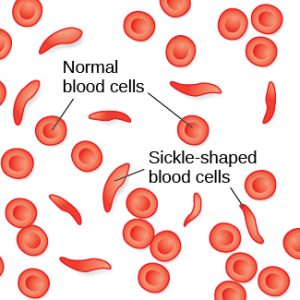
Many people with sickle-cell anemia—and the particular genetic mutation that causes it—die at an early age. While the notion of "survival of the fittest" may propose that people suffering from this illness have a low survival rate and therefore the disease volition go less mutual, this is non the case. Despite the negative evolutionary furnishings associated with this genetic mutation, the sickle-cell factor remains relatively mutual amid people whose ancestors originated in specific parts of Key Africa, the Indian subcontinent and the Middle Eastward. Why is this? The explanation is illustrated with the post-obit scenario.
Imagine two young women—Luwi and Sena—sisters in rural Republic of zambia, Africa. Luwi carries the gene for sickle-cell anemia; Sena does non carry the gene. Sickle-cell carriers have i copy of the sickle-cell gene but do not have full-blown sickle-cell anemia. They experience symptoms but if they are severely dehydrated or are deprived of oxygen (every bit in mountain climbing). Carriers are thought to be immune from malaria (an often deadly affliction that is widespread in tropical climates) considering changes in their blood chemistry and immune functioning prevent the malaria parasite from having its effects. However, full-diddled sickle-cell anemia, with ii copies of the sickle-prison cell cistron, does not provide immunity to malaria.
While walking domicile from school, both sisters are bitten by mosquitos carrying the malaria parasite. Luwi does non get malaria because she carries the sickle-jail cell mutation. Sena, on the other hand, develops malaria and dies just two weeks later. Luwi survives and eventually has children, to whom she may pass on the sickle-cell mutation.
Link to Learning
Visit this website to learn more about how a mutation in Dna leads to sickle-cell anemia.
Malaria is rare in the United States, so the sickle-jail cell gene benefits nobody: the gene manifests primarily in wellness bug—pocket-sized in carriers, astringent in the total-diddled affliction—with no health benefits for carriers. However, the situation is quite dissimilar in other parts of the world, particularly in tropical climates near the equator. In parts of the world where malaria is prevalent, having the sickle-cell mutation does provide wellness benefits for carriers (protection from malaria).
This is precisely the situation that Charles Darwin describes in thetheory of evolution past natural selection ( Figure 2 ), which you learned about in the previous section of this book. In simple terms, the theory states that organisms that are improve suited for their environment will survive and reproduce, while those that are poorly suited for their environment will dice off. In our example, we can come across that every bit a carrier, Luwi's mutation is highly adaptive in her environment; notwithstanding, if she resided in the Usa (where malaria is much less mutual), her mutation could prove plush—with a high probability of the disease in her descendants and pocket-sized health issues of her own.
It is of import to remember, that while sickle-cell anemia alleles are common in some parts of Africa and other parts of the world, this pattern in the geographical distribution of alleles does not mean that sickle-cell anemia is a trait associated with whatever particular race. Race is a social construct, and not a biological concept.
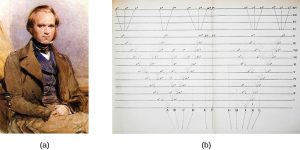
Genetic Variation
Genetic variation, the genetic divergence between individuals, is what contributes to a species' adaptation to its surroundings. In humans, genetic variation begins with an egg, about 100 million sperm, and fertilization. Fertile women ovulate roughly once per month, releasing an egg from follicles in the ovary. During the egg's journey from the ovary through the fallopian tubes, to the uterus, a sperm may fertilize an egg.
The egg and the sperm each contain 23 chromosomes.Chromosomes are long strings of genetic material known every bitdeoxyribonucleic acrid (DNA). DNA is a helix-shaped molecule made up of nucleotide base pairs. In each chromosome, sequences of DNA brand upwardlygenes that command or partially control a number of visible characteristics, known every bit traits, such as eye color, hair color, and then on. A unmarried gene may have multiple possible variations, or alleles. Anallele is a specific version of a cistron. Then, a given cistron may lawmaking for the trait of hair color, and the different alleles of that gene bear upon which hair color an individual has. The sickle-jail cell allele is one version of the hemoglobin gene, and this version of the gene has a different Deoxyribonucleic acid sequence from the normal version of the hemoglobin.
When a sperm and egg fuse, their 23 chromosomes pair upwards and create a zygote with 23 pairs of chromosomes. Therefore, each parent contributes half the genetic information carried past the offspring; the resulting concrete characteristics of the offspring (called the phenotype) are adamant by the interaction of genetic material supplied by the parents (chosen the genotype). A person'sgenotype is the genetic makeup of that individual.Phenotype, on the other mitt, refers to the individual's inherited physical characteristics, which are a combination of genetic and environmental influences ( Figure 3 ).
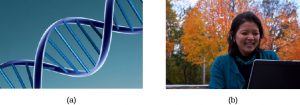
Virtually traits are controlled by multiple genes, but some traits are controlled by i cistron. A characteristic like cleft chin , for example, is influenced by a single gene from each parent. In this example, we will call the cistron for scissure chin "B," and the factor for smooth mentum "b." Fissure mentum is a ascendant trait, which means that having theascendant allele either from one parent (Bb) or both parents (BB) will e'er issue in the phenotype associated with the ascendant allele. When someone has two copies of the aforementioned allele, they are said to behomozygous for that allele. When someone has a combination of alleles for a given gene, they are said to beheterozygous. For case, smooth mentum is a recessive trait, which means that an individual will only display the smooth chin phenotype if they are homozygous for thatrecessive allele(bb).
Imagine that a woman with a fissure chin mates with a man with a smooth chin. What type of chin will their kid have? The answer to that depends on which alleles each parent carries. If the woman is homozygous for cleft chin (BB), her offspring volition always have crack chin. It gets a little more than complicated, yet, if the mother is heterozygous for this gene (Bb). Since the father has a smooth chin—therefore homozygous for the recessive allele (bb)—we can expect the offspring to have a 50% chance of having a crack mentum and a 50% chance of having a smoothen chin ( Figure 4 ).
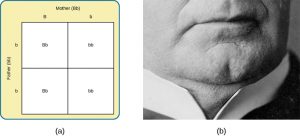
Sickle-prison cell anemia is just 1 of many genetic disorders caused by the pairing of two recessive genes. For example, phenylketonuria (PKU) is a condition in which individuals lack an enzyme that usually converts harmful amino acids into harmless byproducts. If someone with this condition goes untreated, he or she volition experience significant deficits in cognitive function, seizures, and increased risk of various psychiatric disorders. Because PKU is a recessive trait, each parent must have at least one copy of the recessive allele in gild to produce a kid with the condition ( Figure 5 ).
So far, we accept discussed traits that involve just one gene, only few human being characteristics are controlled by a unmarried factor. Most traits arepolygenic: controlled by more than than one cistron. Tiptop is one instance of a polygenic trait, as are skin colour and weight.
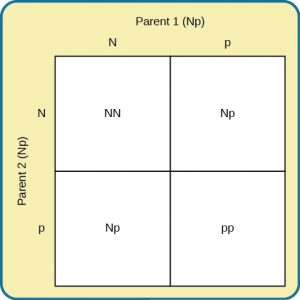
Where do harmful genes that contribute to diseases like PKU come from? Gene mutations provide one source of harmful genes. Amutation is a sudden, permanent change in a gene. While many mutations can be harmful or lethal, one time in a while, a mutation benefits an individual past giving that person an advantage over those who do not have the mutation. Recall that the theory of evolution asserts that individuals all-time adapted to their particular environments are more likely to reproduce and pass on their genes to future generations. In club for this process to occur, in that location must exist competition—more than technically, there must exist variability in genes (and resultant traits) that allow for variation in adaptability to the surround. If a population consisted of identical individuals, then any dramatic changes in the environs would bear on everyone in the same fashion, and in that location would be no variation in pick. In contrast, diversity in genes and associated traits allows some individuals to perform slightly amend than others when faced with environmental change. This creates a distinct advantage for individuals all-time suited for their environments in terms of successful reproduction and genetic transmission.
*
Gene-Environment Interactions
Genes do not exist in a vacuum. Although nosotros are all biological organisms, we also exist in an environment that is incredibly of import in determining non only when and how our genes express themselves, only besides in what combination. Each of us represents a unique interaction betwixt our genetic makeup and our environment; range of reaction is ane way to describe this interaction.Range of reaction asserts that our genes set the boundaries within which we can operate, and our environment interacts with the genes to determine where in that range nosotros volition fall. For case, if an individual's genetic makeup predisposes her to high levels of intellectual potential and she is reared in a rich, stimulating environment, then she volition be more likely to reach her full potential than if she were raised under conditions of significant deprivation. According to the concept of range of reaction, genes fix definite limits on potential, and environment determines how much of that potential is accomplished. Some disagree with this theory and argue that genes practise not fix a limit on a person's potential.
Some other perspective on the interaction between genes and the environment is the concept ofgenetic environmental correlation. Stated merely, our genes influence our environment, and our environment influences the expression of our genes ( Effigy 6 ). Non just practise our genes and environment collaborate, as in range of reaction, but they also influence one another bidirectionally. For example, the child of an NBA player would probably be exposed to basketball from an early age. Such exposure might permit the child to realize his or her total genetic, able-bodied potential. Thus, the parents' genes, which the child shares, influence the kid's environment, and that environs, in plow, is well suited to support the kid'southward genetic potential.
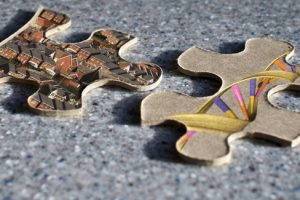
In another approach to gene-environment interactions, the field ofepigenetics looks across the genotype itself and studies how the same genotype can exist expressed in unlike ways. In other words, researchers written report how the aforementioned genotype can lead to very dissimilar phenotypes. As mentioned earlier, gene expression is oft influenced by environmental context in ways that are not entirely obvious. For instance, identical twins share the aforementioned genetic information (identical twins develop from a single fertilized egg that split, so the genetic material is exactly the aforementioned in each; in dissimilarity,fraternal twins develop from ii dissimilar eggs fertilized by different sperm, so the genetic material varies as with not-twin siblings). Simply even with identical genes, at that place remains an incredible amount of variability in how gene expression can unfold over the course of each twin's life. Sometimes, one twin volition develop a disease and the other will non. In one example, Tiffany, an identical twin, died from cancer at historic period vii, but her twin, at present 19 years old, has never had cancer. Although these individuals share an identical genotype, their phenotypes differ every bit a effect of how that genetic information is expressed over time. The epigenetic perspective is very unlike from range of reaction, because here the genotype is not fixed and limited.
Link to Learning
Visit this site for an engaging video primer on the epigenetics of twin studies.
Genes affect more our concrete characteristics. Indeed, scientists have found genetic linkages to a number of behavioral characteristics, ranging from bones personality traits to sexual orientation to spirituality (for examples, see Mustanski et al., 2005; Comings, Gonzales, Saucier, Johnson, & MacMurray, 2000). Genes are likewise associated with temperament and a number of psychological disorders, such as low and schizophrenia. So while it is truthful that genes provide the biological blueprints for our cells, tissues, organs, and body, they also accept meaning touch on our experiences and our behaviors.
Let's expect at the following findings regarding schizophrenia in low-cal of our 3 views of gene-environment interactions. Which view do you think all-time explains this testify?
In a study of people who were given up for adoption, adoptees whose biological mothers had schizophreniaand who had been raised in a disturbed family surround were much more likely to developschizophrenia or another psychotic disorder than were any of the other groups in the study:
- Of adoptees whose biological mothers had schizophrenia (loftier genetic adventure) and who were raised in disturbed family environments, 36.eight% were likely to develop schizophrenia.
- Of adoptees whose biological mothers had schizophrenia (high genetic risk) and who were raised in good for you family environments, five.eight% were likely to develop schizophrenia.
- Of adoptees with a depression genetic adventure (whose mothers did not accept schizophrenia) and who were raised in disturbed family environments, 5.three% were likely to develop schizophrenia.
- Of adoptees with a low genetic risk (whose mothers did non have schizophrenia) and who were raised in healthy family environments, 4.eight% were likely to develop schizophrenia (Tienari et al., 2004).
The study shows that adoptees with loftier genetic take chances were peculiarly likely to develop schizophrenia only if they were raised in disturbed home environments. This research lends credibility to the notion that both genetic vulnerability and environmental stress are necessary for schizophrenia to develop, and that genes alone practice not tell the total tale.
*
Section Summary
Genes are sequences of DNA that lawmaking for a detail trait. Dissimilar versions of a cistron are called alleles—sometimes alleles can be classified as dominant or recessive. A dominant allele always results in the dominant phenotype. In order to exhibit a recessive phenotype, an individual must be homozygous for the recessive allele. Genes bear upon both physical and psychological characteristics. Ultimately, how and when a cistron is expressed, and what the outcome will be—in terms of both physical and psychological characteristics—is a function of the interaction between our genes and our environments.
*
Glossary
- allele
- specific version of a cistron
- chromosome
- long strand of genetic information
- deoxyribonucleic acid (DNA)
- helix-shaped molecule made of nucleotide base pairs
- dominant allele
- allele whose phenotype will be expressed in an individual that possesses that allele
- epigenetics
- study of gene-environment interactions, such equally how the same genotype leads to unlike phenotypes
- fraternal twins
- twins who develop from two different eggs fertilized by different sperm, then their genetic cloth varies the same as in non-twin siblings
- gene
- sequence of Deoxyribonucleic acid that controls or partially controls physical characteristics
- genetic environmental correlation
- view of gene-environment interaction that asserts our genes impact our environment, and our environment influences the expression of our genes
- genotype
- genetic makeup of an individual
- heterozygous
- consisting of two unlike alleles
- homozygous
- consisting of two identical alleles
- identical twins
- twins that develop from the aforementioned sperm and egg
- mutation
- sudden, permanent modify in a gene
- phenotype
- private's inheritable physical characteristics
- polygenic
- multiple genes affecting a given trait
- range of reaction
- asserts our genes set the boundaries within which we can operate, and our environment interacts with the genes to determine where in that range we volition fall
- recessive allele
- allele whose phenotype will be expressed only if an individual is homozygous for that allele
- theory of evolution by natural choice
- states that organisms that are better suited for their environments volition survive and reproduce compared to those that are poorly suited for their environments
Source: https://open.lib.umn.edu/humanbiology/chapter/2-1-human-genetics/
Posted by: hughesthind1949.blogspot.com

0 Response to "The Physical Appearance Of An Individual's Genetic Makeup?"
Post a Comment